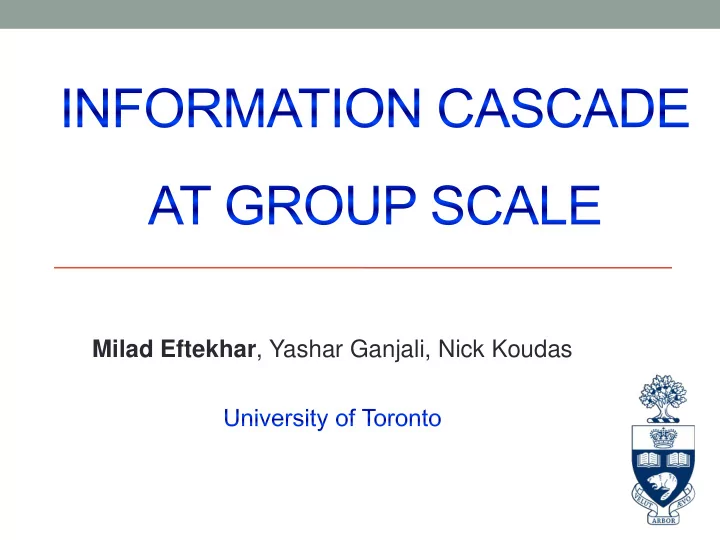

Milad Eftekhar , Yashar Ganjali, Nick Koudas
Introduction • Identifying the 𝑙 most influential individuals is a well- studied problem. • We generalize this problem to identify the 𝑚 most influential groups . • Application: • Companies often target groups of people • E.g. by billboards, TV commercials, newspaper ads, etc. 2
Group targeting • Groups Billboard • Advantages • Improved performance • Natural targets for advertising • An economical choice 3
Fine-Grained Diffusion (FGD) • Determine how advertising to a group translates into individual adopters. • Run individual diffusion process on these adopters. 4
FGD Modeling • Graph 𝐻′ : add a node for each group, add edges between a node corresponding to a group 𝑗 and its members with weight 𝑥 𝑗 that depends on • Advertising budget, size of group, the escalation factor, and the budget needed to convince an individual 5
FGD Modeling (Cont’d) • Escalation Factor 𝛾 : how many more initial adaptors we can get by group targeting rather than individual targeting. Individual Targeting Group Targeting Advertising budget Advertising budget $1000 $1000 Cost of convincing an individual Billboard $100 Audience = 10000 Cost = $1000 individuals 20 initial adopters 10 initial adopters 𝛾 = 20 10 = 2 6
FGD Modeling (Cont’d) • Escalation Factor 𝛾 • Based on the problem structure, the size and shape of the network, the initial advertising method, etc. • Individual advertising: 𝛾 = 1 • Billboard advertising: 𝛾 = 200 • Online advertising: 𝛾 = 400 7
Problem statement • Goal : Find the 𝑚 most influential groups (blue group- nodes) Top-2 Top-2 influential influential groups groups • NP-hard under FGD model 8
topfgd algorithm • Diffusion in FGD is monotone and submodular • topfgd: a greedy algorithm provides a (1-1/e) approximation factor. • In each iteration, add the group resulting to the maximum marginal increase in the final influence. • Time: 𝑃 ( 𝑚 × 𝑛 ×| 𝐹 𝑗𝑜𝑒 |× 𝑆 ) 9
Coarse-Graind Diffusion (CGD) • FGD is not practical for large social networks • Idea: incorporate information about individuals without running explicitly on the level of individuals • A graph to model inter-group influences Group 1 10
CGD Modeling • Differences with “Individual Diffusion” models • No binary decisions • Progress fraction for each group • Two types of diffusion • Inter-group diffusion Progress fraction = 0.6 • Intra-group diffusion • Submodularity? 11
CGD Diffusion Model • Each newly activated fraction of a group can activate its neighboring groups • As a result of an activation attempt from A to B, some activation attempts also occur between members of B • Continue for several iterations to converge 0 0 0.04 → 0.05 Group 1 Group 1 0 0 → 0.04 0 0.2 0.2 0 0 → 0.2 12
topcgd algorithm • Goal : Find the 𝑚 most influential groups • NP-hard under CGD model • Diffusion in CGD is monotone and submodular • topcgd: a greedy algorithm provides a (1-1/e) approximation factor. • Time: 𝑃( 𝐹 𝑗𝑜𝑒 + 𝑛𝑚 𝑛𝑢 + 𝑜 ) • 𝑢 is the number of iterations to converge (~10) 13
Experimental setup • Datasets: • DBLP: 800K nodes, 6.3M edges, 3200 groups • Comparison • Spend same advertising budget on all algorithms • Measure the final influence (the number of convinced individuals) • Run Individual Diffusion process on the initial convinced individuals 14
Results • DBLP-1980: 8000 nodes, 69 groups • Compare topid vs. topfgd vs. topcgd • Final influence: topfgd and topcgd outperform topid for 𝛾 > 3 • Time: topid (30 days), topfgd (an hour), topcgd (0.2 sec) topfgd topcgd topid 6000 final influence 5000 4000 3000 2000 1000 0 0 10 20 30 40 50 60 70 80 90 100 β 15
Results (Cont’d) • DBLP: topcgd vs. Baselines • rnd, small, big, degree • Time of topcgd : 100 minutes • topfgd and topid not practical topcgd degree big rnd small 70000 60000 final influence 50000 40000 30000 20000 10000 0 10 30 50 70 90 β 16
Conclusion and Future Works • Focus on groups rather than individuals • Wider diffusion • Improved performance • More less influential individuals vs. less more influential individuals • Although CGD aggregates the information about individuals (hence improved performance), it results to final influence comparable to FGD. • We are interested in a generalized model where • Groups are allowed to receive different budgets • The cost of advertising to each group is predetermined 17
Thanks! (Questions?) 18
Recommend
More recommend